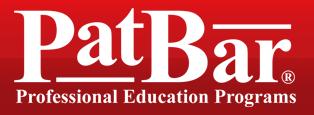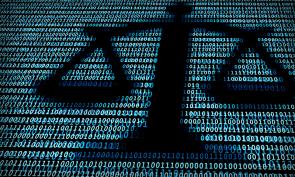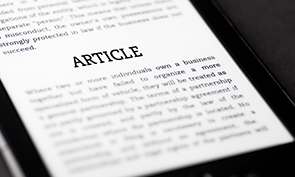
Considering that the passage rate for the patent bar (more formally known as the Examination for Registration to Practice in Patent Cases Before the United States Patent and Trademark Office) has ranged from a dismal 37 percent to a somewhat more optimistic 70 percent over the last few years, knowing what you are getting into and how to increase your chances of success are important.
Having passed the exam, those who have already passed the standard bar exam in any U.S. state or territory will become patent attorneys, whereas those who have not passed the bar exam and are not lawyers will become patent agents, who cannot give legal advice or represent clients in court.
To be qualified to sit for the patent bar, an applicant must have (1) good moral character, (2) the scientific or technical qualifications needed to render good services, and (3) the competence to give advice and assistance to applicants in the presentation and prosecution of patent applications.
To fulfill the second criterion, an applicant can satisfy it through a Category A criterion of having gained a bachelor's degree in a technical subject such as biology, chemistry, computer science, engineering, or physics. The Category B criterion requires a candidate to have taken a certain amount of technical courses, and the standards are exacting. The Category C requirement is passing the daunting Fundamentals of Engineering Exam.
The examination is a 100-question multiple choice test administered in two 3-hour sessions of 50 questions apiece. The questions measure the applicant's knowledge of United States Patent and Trademark Office (USPTO) procedures. Those taking the test may use an electronic version of the Manual of Patent Examining Procedure (MPEP).
So what's the best way to prepare for the patent bar? As with any exam, but especially with something as daunting as the bar, you want to familiarize yourself as thoroughly as possible with what you are getting into. That of course means beginning your preparation months, if not a year, in advance.
As the exam is "open book" regarding the Manual of Patent Examining Procedure, you want to be familiar with this resource. It is not recommended that you study exclusively from this book, though the answers to all you will be questioned on reside within, because the book is cumbersome. You will get a better clue as to what material to spend the most time studying by looking at previous exams, and using free or premium study aids and courses. Nevertheless, you will want to know the chapter headings, and have a familiarity with how to navigate your way through the resource quickly and with ease.
Practice exams are essential. By the time you take the real deal, you want to feel at ease with the exam and all that is expected of you. There are plenty of free examples of the exam online, or questions used on prior exams, so discover every version of it you can. USPTO provides three example exams. Take them if you can in the same manner as the test itself. Considering that around 200 hours will suffice for preparation, spending a large chunk of that taking exams is a must.
After you take the exam, look up every question, not only the ones you got wrong but also the ones you got right, so that you are familiar with how to find the materials you need within the MPEP. This process may feel a bit belabored but the fluency you will gain with your one allotted resource for the exam will be worth your effort.
When you read through the MPEP, be sure to note what areas confuse you, and mark them for further consideration. After attending your study aids and taking practice exams, return to these trouble spots and see if it makes more sense.
The better you can wrap your mind around the structure of patent laws and procedures, the more relaxed and confident you will be on the exam. By taking the time to make notes of your study material and working them into outlines and diagrams, the better your mind will be at recalling.
So study actively. Don't merely read and blandly highlight every interesting sentence. Take notes in the margins, ask questions, note connections, make diagrams and outlines. Get a gestalt sense of the MPEP and, as far as is possible in the time you've decided to give to this, know it like the back of your hand.
Familiarize yourself as well with the patent laws and procedures. The consolidated patent laws and the consolidated patent procedures are provided by the USPTO to use to prepare for the test.
Taking the time to administer the practice tests yourself will put you in the mindset of the test. Looking up every answer to know why it is true or false will familiarize you with the MPEP. Nevertheless, the first time you take the test you need not time yourself. Work up to that. And when you review all the answers, with your first exam or two don't rush things.
Necessarily you will want to take the Patent Bar tutorial Prometric offers to prepare you for the test. As the exams are administered by Prometric, using them as a resource makes sense.
You also should maximize the use of the study materials the USPTO gives, the case law reviews, supplementary rules, and so forth - get the most out of these free avenues as you can. After all, you will "pay" for them by how much you apply to figuring them out and integrating the information into your comprehension of the materials as a whole.
Even if you decide to take an online course or other courses available, which can cost from hundreds to thousands of dollars, it is best to make use of the starting material put out by the USPTO and Prometric - to get the most you can out of the basics. If you are scoring well on the practice exams - 70 percent is passing - you might save yourself some time and money by skipping the premium services. If, however, you lack confidence or are not passing the exams, you might decide to invest in a review course, and there are many to choose from.
A variety of courses is available online, and can be brought up with a quick search. Wysebridge Patent Bar Review is a relatively affordable one. At $349 it offers all its courses online, with easy to use study platforms, questions from the latest exam, chapter summaries, interactive testing simulators, frequency charts of various exam questions that are repeated, a monthly analysis, study planners, and a response team. Once you’ve cleared the Patent Bar, explore your career opportunities in this comprehensive guide for patent attorneys in 2025.

More expensive courses include the Pat Bar, a popular option. It offers a home study course with CD, a Patent Bar simulator, flashcards, and a searchable MPEP, with a price at $695.

Omni Prep offers a 100 percent money back guarantee, a 6 month study plan, live lectures, and 8 full length timed exams, all for $485.

Practicing Law Institute (PLI) offers highly recommended live and home study courses, for $2,795, and the cost is cheaper for students.

Other courses to consider include the Bullseye Patent Bar Prep and MyPatentBar.com
Though these courses require investing money, they will not do your studying for you, and the necessary reality to hold in mind is you are going to do well if you work enough to prepare for it. What matters especially is getting your MPEP search speed up, so even if you sign up for a live or home course, bear in mind that you will want to run through every exam's questions with the MPEP, that you will have wanted to have perused it chapter by chapter, taking notes and making outlines.
Courses are great for orienting you towards the most relevant material, and clueing you in to what questions are most likely to be repeated. Just flat out slogging through the MPEP on its own would be too cumbersome, so some alternation between the two will be your best bet in preparing for the exam.
The courses will clue you in to what chapters of the MPEP require the most attention, such as chapter 700 and 2100. With suggested study plans you can get a good outline of how to schedule your next few months.
However, with or without the supplement of a study course, which you probably could avoid if you are self-disciplined and have done well setting your schedule in college, you will need to decide in advance a schedule for your months coming up to the exam. Though of course you will make changes and allowances as you progress, have an idea of how many practice exams you take, and mark out the long blocks necessary to take them. Make a daily regime in which you set a definite block aside each day for you to focus entirely on your studies. It may be cumbersome, but hold to it, and keep studying. What matters most of all is having studied at a steady consistent pace. As you well know by now, this sort of test cannot be won by a heroic effort at the very end.
Make objective measurable goals for yourself as to what score you want on the practice exams, and when you want them, and then work backwards when working out your schedule as to how you want to get there. For instance, a good goal to have would be to be able to search the MPEP where you can find 25-35 answers in an hour.
Be a collector of old questions and let it be somewhat of an obsession. Memorize them, especially the ones that are repeat questions. Doing past exams is key to passing, so you could make it a weekend ritual to take a practice exam and grade it. During the week, on the other hand, you could review the study materials you have found or the course materials you have purchased, and set aside time, preferably each morning first thing in the morning, to do so. The advantage of doing your study first thing is that you put your first thrust of vitality into it. Furthermore, as with exercise programs, you are more likely to remain loyal to it if you finish it first thing in the morning than if you put it off till the final thing at night.
As with the old dictum, "don't panic, plan it," once you make a study regime that gives you confidence, you can relax and simply do it. Break down your goals into parts you can achieve daily. You will want to memorize chapter titles of the MPEP so that you can navigate it better. You will want to outline and summarize the contents of each chapter.
Taking a course might make you feel more comfortable, since you will then be in the competent hands of professionals who know what they are doing. Taking a live course, or joining an online forum, can put you in a community offering support and admonitions, which will make you feel all that much more confident about your study and progress.
As many courses recommend about 200 hours of study before the exam, remember that this is entirely doable, and within the circumference of your capability. Schedule the hours and find a way to monitor progress. Ostensibly the best way to do that is to see how you are doing on the practice exams.
As for taking the exam itself, the standard advice is to get sufficient sleep not only the day before the exam, but also the day before that as well. Get on an exercise schedule, especially the month before the exam, and do some cardio the morning before you take it. Eat a well-balanced diet, have a cup of coffee, and of course be to the exam on time. That means knowing where the testing center is, having visited it in advance so there is no extra anxiety about finding the place or getting there on time. Having done those preliminaries, and having studied, you will do great. Good luck!
If you have passed the patent bar and are looking for work, take a look at these patent attorney recruiters to find a good opportunity in your area.
CLICK HERE TO SEARCH JOBS IN OTHER STATES!




